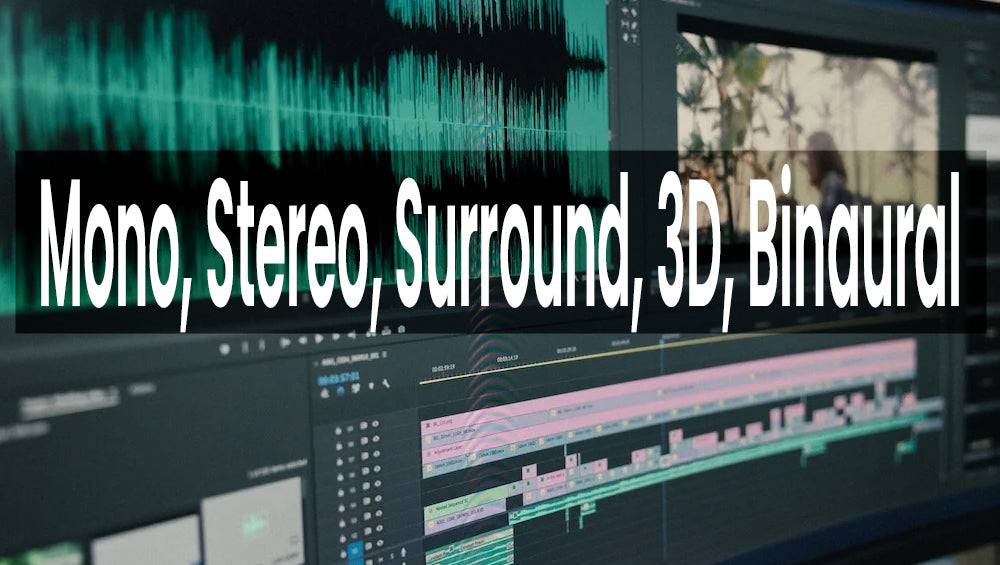There’s more to sound than just mere noise. If you love listening to music, watching movies, playing games, or creating audio content, you might have wondered time on time about the different types of sounds that exist and how they affect your overall listening experience.
It turns out that not all sounds are created equal. Depending on how they are recorded, processed, or reproduced, different kinds of sounds have different qualities, characteristics, and effects.
And in this article, we will explore some of the most common types of sound that you encounter in your everyday life, such as mono, stereo, binaural, surround, and 3D. For each sound type, we will explain what they mean, how they work, and when they are best used. So, let’s get started!
Mono Sound

What is Mono Sound?
Mono sound, or monophonic sound, is a type of sound that uses one audio channel and one microphone to record or playback sound. It is intended to be heard as if it were coming from one position.
Although only one loudspeaker is needed for mono sound, multiple loudspeakers can also be used with identical signals. For those who might get confused here, NO, this is in no way a stereo sound.
Mono sound remained the standard for audio recording and reproduction until the 1950s when stereo sound emerged as a new technology and offered better audio quality and realism.
Mono Sound History
The history of mono sound goes back to the late 19th century when Thomas Edison invented the phonograph, the first machine capable of recording and reproducing sound.
Edison’s phonograph made use of a horn and a needle to make marks on a wax cylinder, which could then be played back by vibrating the needle and amplifying the sound by the horn. Although the phonograph was a marvel of its time, it had many limitations, such as low fidelity, distortion, and noise.
Mono Sound Features
Mono sound has some features that make it still useful and relevant today. Some of these features are:
- Mono sound is easier to transmit and receive than stereo sound, as it requires less bandwidth and power.
- Mono sound is more compatible with older playback systems that have only one speaker or head.
- Mono sound can be more intelligible and clearer than stereo sound in some situations, such as when there is background noise or interference.
Real-Life Use Cases
Following are just some of the many real-life use cases for mono sound today.
- AM radio that stations broadcast in mono sound to maximize their coverage area and signal strength.
- Phone speakers that use mono sound to deliver clear and loud voice calls.
- Audiobooks that use mono sound to focus on the narration and avoid distraction from other sounds.
Stereo Sound

What is Stereo Sound?
Stereo sound, or stereophonic sound, is a type of sound that uses two or more audio channels to create a sense of depth and width. Sound is recorded on two different channels and then mixed or blended back together for playback.
Stereo sound became popular in the 1950s, when it was introduced in movies, radio, and music; as it was able to create a more immersive and realistic experience for the audience by matching the sound with the movement of the actors on the screen, or by creating more complex and creative mixes of instruments and vocals. One of the most notable upgrades in stereo sound was that it improved the audio quality and fidelity of recordings by reducing noise and distortion.
Stereo Sound History
The history of stereo sound goes back to the late 19th and early 20th centuries when engineers and inventors were exploring new ways to create more immersive and lifelike audio experiences.
One of the earliest experiments was conducted by British engineer Alan Dower Blumlein in the 1930s, who patented the first true stereo sound recording and playback system. Blumlein’s system made use of two microphones to record sound from two different perspectives, which allowed for a more realistic representation of sound when played back over two channels.
Stereo Sound Features
Stereo sound has some features that make it superior to mono sound in many situations. Some of these features are:
- Stereo sound can create a sense of direction and space, as it can place sounds in different positions relative to the listener.
- Stereo sound can separate different elements of the sound, such as vocals, instruments, effects, etc., and give them more clarity and definition.
- Stereo sound can create a wider and fuller sound stage, as it can spread sounds across a larger area.
Real-Life Use Cases
Following are just some of the many real-life use cases for stereo sound today.
- Music albums that use stereo sound to create different effects, such as panning, reverb, delay, chorus, etc., or to emphasize certain parts of the song, such as solos, choruses, bridges, etc.
- Movies that use stereo sound to create a more cinematic and engaging experience for the viewers, by matching the sound with the visuals, or by adding sounds that are not present in the scene, such as music, narration, or sound effects.
- Video games that use stereo sound to create a more interactive and immersive experience for the players.
Binaural Sound

What is Binaural Sound?
Binaural sound, or binaural audio, is a type of sound that uses two microphones to record sound from the perspective of a human listener. It is intended to create a 3D stereo sound sensation for the listener of actually being in the room with the performers or instruments.
The binaural sound became more advanced in the 1970s when dummy head recording was introduced. Dummy head recording is a technique that uses a mannequin head fitted with a microphone in each ear. The dummy head mimics the shape and size of a human head, as well as the filtering effects of the outer ears, or pinnae. The dummy head can capture the subtle differences in sound that reach each ear, such as interaural time differences (ITDs) and interaural level differences (ILDs). These differences help the brain locate the direction and distance of sound sources.
Binaural Sound History
The history of binaural sound dates back to 1881, when the first binaural/3D sound device, the théâtrophone, was invented by Clément Ader. It consisted of an array of carbon telephone microphones installed along the front edge of the Opera Garnier. The signal was sent to subscribers through the telephone system and required that they wear a special headset, which had a tiny speaker for each ear. The théâtrophone was able to transmit live performances from the opera house to the listeners’ homes.
Binaural Sound Features
Binaural sound has some features that make it more immersive and realistic than other types of sound. Some of these features are:
- Binaural sound can create a sense of depth and width, as it can place sounds in different positions relative to the listener.
- Binaural sound can create a sense of height, as it can account for the effects of the pinnae on sound waves.
- Binaural sound can create a sense of movement, as it can track the changes in sound that occur when the listener or the sound source moves.
Real-Life Use Cases
Following are just some of the many real-life use cases for binaural sound today.
- Video games that use binaural sound to create a more interactive and immersive experience for the players.
- ASMR (autonomous sensory meridian response) videos that use binaural sound to trigger tingling sensations and relaxation for the listeners.
- Virtual reality (VR) applications that use binaural sound to create a more realistic and believable environment for the users.
Surround Sound

What is Surround Sound?
Surround sound is a technique for enriching sound reproduction by using multiple audio channels from speakers that surround the listener. It creates the sensation of sound coming from any horizontal direction around the listener and enhances the illusion of live hearing as such.
To experience surround sound, one needs media with audio mixed for surround sound, a proper AV receiver, and an assortment of speakers properly placed around the sitting area. There are different formats and configurations of surround sound for home theater systems, such as 5.1, 6.1, and 7.1.
5.1 Channel Sound
5.1 channel sound is a standard sound format for movies and music that has five main sound channels and a sixth subwoofer channel (called the point-one channel), which is used for bass effects and movie sounds.
A 5.1-channel system has a pair of front speakers, a center speaker in the middle of the front speakers, and two surround speakers behind the listener. The most common 5.1 channel formats are Dolby Digital 5.1 and DTS Digital Surround.
6.1 Channel Sound
6.1 channel sound is an improvement over 5.1 channel sound as it adds an extra center surround speaker between the two surround speakers behind the listener. As such, the 6.1 channel sound creates a more immersive surround sound experience.
DTS-ES, Dolby Digital EX, and THX Surround EX are some examples that implement the 6.1 channel sound configuration
7.1 Channel Sound
Just like 6.1, 7.1 channel sound is yet another enhancement over the 5.1 channel sound with two more side surround speakers on the sides of the listener’s seat. It is used for an even better sound envelopment and more precise sound positioning.
Needless to say, 7.1 audio formats are the most detailed of all. These formats are not compressed and are the same as the original studio recording. DTS-HD Master Audio and Dolby TrueHD are two such formats.
Surround Sound History
The history of surround sound goes back to 1940 when the Disney studio’s animated film Fantasia used the Fantasound technology to create a surround sound field with five main channels and a subwoofer channel. Since then, surround sound has evolved and improved with various technologies and standards, such as Dolby, DTS, THX, and Atmos.
Surround Sound Features
Surround sound has some features that make it more immersive and realistic than other types of sound. Some of these features are:
- Surround sound can create a sense of depth and width, as it can place sounds in different positions relative to the listener.
- Surround sound can separate different elements of the sound, such as vocals, instruments, effects, etc., and give them more clarity and definition.
- Surround sound can create a wider and fuller sound stage, as it can spread sounds across a larger area.
Real-Life Use Cases
The Real-life use cases for surround sound are just the same as for stereo sound. The only difference is that surround sound is more accurate and truer to the original sound and delivers a top-notch cinematic listening experience.
3D Sound

What is 3D Sound?
3D sound, or 3D audio, is a type of sound that creates a three-dimensional sonic space around the listener. It works by simulating the natural sound environment and making the listener feel like they are in the middle of the action. This, in turn, can enhance the realism and immersion of audio content for users, such as music, movies, games, and VR/AR applications.
3D Sound History
The history of 3D sound goes back to the late 19th century, when the first device that produced 3D sound, the théâtrophone, was invented by Clément Ader in France. It used an array of microphones and headphones to transmit live performances from the opera house to the listeners’ homes.
Later, in 1940, Disney’s Fantasia used the Fantasound technology to create a surround sound field with five main channels and a subwoofer channel.
Since then, 3D sound has evolved and improved with various technologies and standards, such as binaural recording, dummy head recording, Dolby, DTS, THX, and Atmos. These technologies use different methods to capture and reproduce the spatial information of sound sources, such as their direction, distance, elevation, and movement.
3D Sound Features
Some features of 3D sound that make it more immersive and realistic than other types of sound are:
- 3D sound can create a sense of depth and width, as it can place sounds in different positions relative to the listener.
- 3D sound can create a sense of height, as it can account for the effects of the pinnae (the outer ears) on sound waves.
- 3D sound can create a sense of movement, as it can track the changes in sound that occur when the listener or the sound source moves.
Real-Life Use Cases
The Real-life use cases for 3D sound are just the same as for binaural sound. The only difference is that 3D sound also takes into account the height as well as the movement of sound sources which helps in delivering a next-level cinematic listening experience.
Final Thoughts
As seen above, there are many different types of sounds that are used to enhance our enjoyment of various forms of entertainment, such as music, movies, games, or podcasts. This should not come about as a surprise since sound is a means of conveying information, emotion, as well as atmosphere in one’s life.
I hope you now have a better understanding of the sound world. If there are any questions, feel free to ask us in the comments below!



